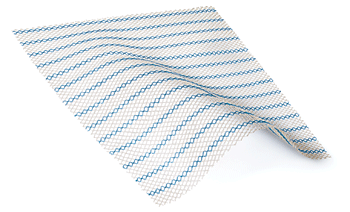The British Hernia Centre’s preferred method in most cases
A number of surgeons felt that none of the existing methods was entirely desirable and over several years an altogether different technique was devised. This formed the basis for the method now perfected at The British Hernia Centre over many tens of thousands of cases.
Under local anaesthesia, a small incision is made over the site of the hernia.  The peritoneal bulge is returned to where it belongs, but the repair is achieved by placing a piece of fine (inert and sterile) mesh at the opening in the tissue. This is firmly held in place and the outer incision closed. The whole operation takes minutes to perform.
The peritoneal bulge is returned to where it belongs, but the repair is achieved by placing a piece of fine (inert and sterile) mesh at the opening in the tissue. This is firmly held in place and the outer incision closed. The whole operation takes minutes to perform.
Unlike other techniques, even those now using mesh, our approach does not require any stitching together of the muscle tissue at all, thus eliminating the tension induced by other methods.
The healing process starts to take place immediately whereby, (sensing the presence of the fine mesh) the muscle and tendon send out fibrous tissue which grows around and through the mesh, incorporating it in a way similar to the placing of the steelwork inside reinforced concrete. It is not a “patch” stuck on the outside, (as is relatively common with mesh repairs) but a total, tension-free reinforcement inside the abdominal wall itself. The results are also similar to the concrete analogy, in that the mechanical load is spread over the whole area, precisely at the area of weakness, rather than on high pressure points of stitching through the deep, sensitive tissue with older methods.
 When performed correctly, this technique requires no bed-rest, even after the operation. The patient is able to walk away from the theatre immediately after surgery. The mesh itself is made of the same material as surgical sutures (stitches), inert and sterile and there is no negative interaction or rejection with the surrounding tissue. It is very light in weight and the patient is unaware of its presence.
When performed correctly, this technique requires no bed-rest, even after the operation. The patient is able to walk away from the theatre immediately after surgery. The mesh itself is made of the same material as surgical sutures (stitches), inert and sterile and there is no negative interaction or rejection with the surrounding tissue. It is very light in weight and the patient is unaware of its presence.
The technique was originally devised as a much-needed alternative to restitching failed hernia operations (i.e. recurrences) done the old way. It was then realised that, as the technique was so very successful with recurrent hernias, it should be used for first-time repairs and thus avoid recurrences altogether. Typically, with this technique:
- A painless operation that takes minutes to perform
- No need for general anaesthesia
- No need for bed-rest, even after the operation
- Home the same day
- Back to normal extremely quickly (back at work within days)
- All kinds of sport possible afterwards
- Most reliable against recurrence for life
- Advanced age no longer a barrier
To see typical recovery experiences afterwards click here (opens in a separate window)
The papers we have had published in the academic journals, plus the press and broadcast publicity surrounding the success we achieve with our technique has encouraged many, if not most surgeons to use mesh now, rather than stitching. However, not only are there several different types of mesh in use, both in material and in construction, but there are several ways of using mesh and many levels of training and experience and the results vary enormously.
NB: The results we refer to, apply to our own techniques, performed by our own specially trained and experienced team of consultant surgeons.
Academic References:
- A unique wealth of papers by the Surgeons of The British Hernia Centre in support and evidence of the techniques developed and described have been published in the world’s leading academic journals.
- An extract appears on the menu to the left, under Academic Publications
